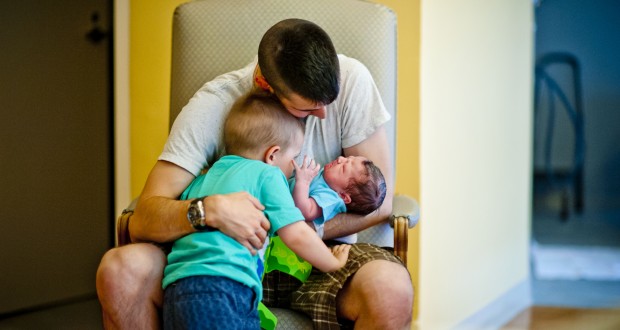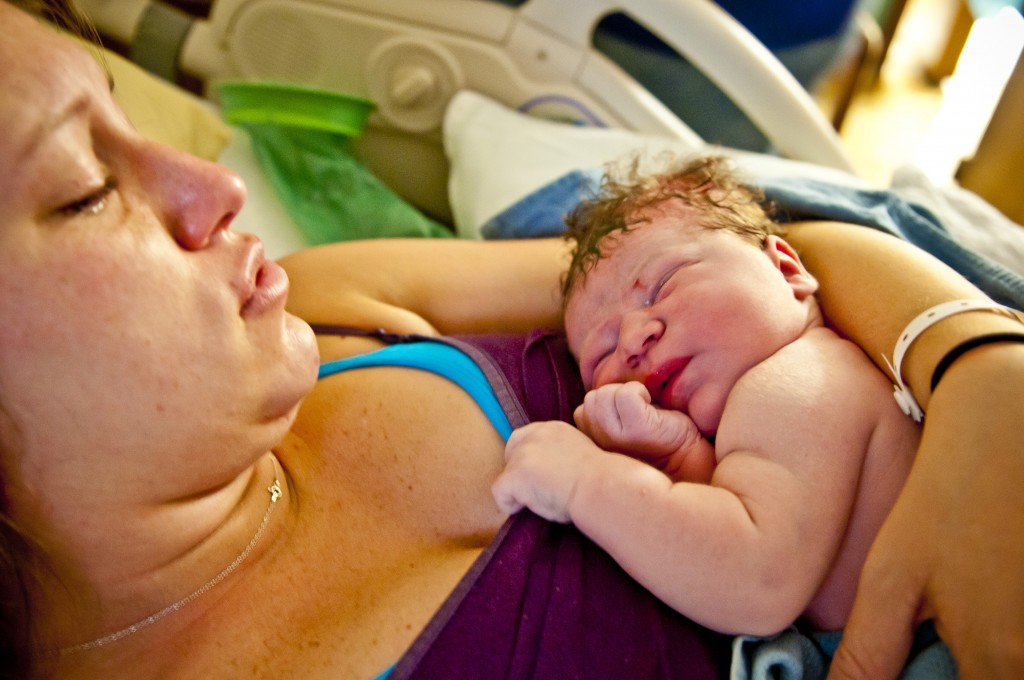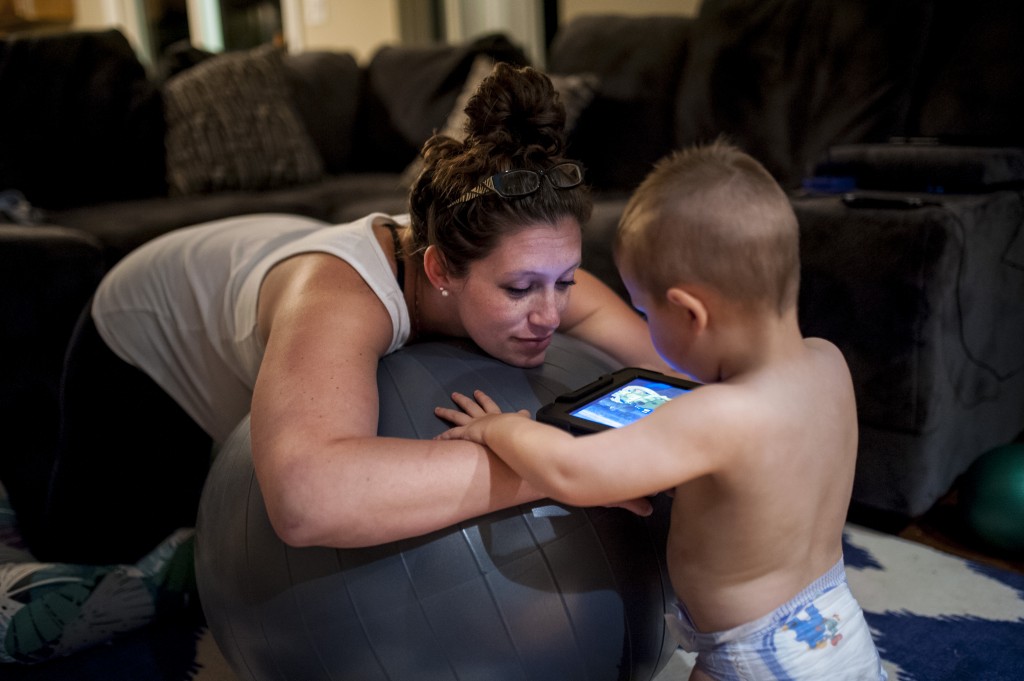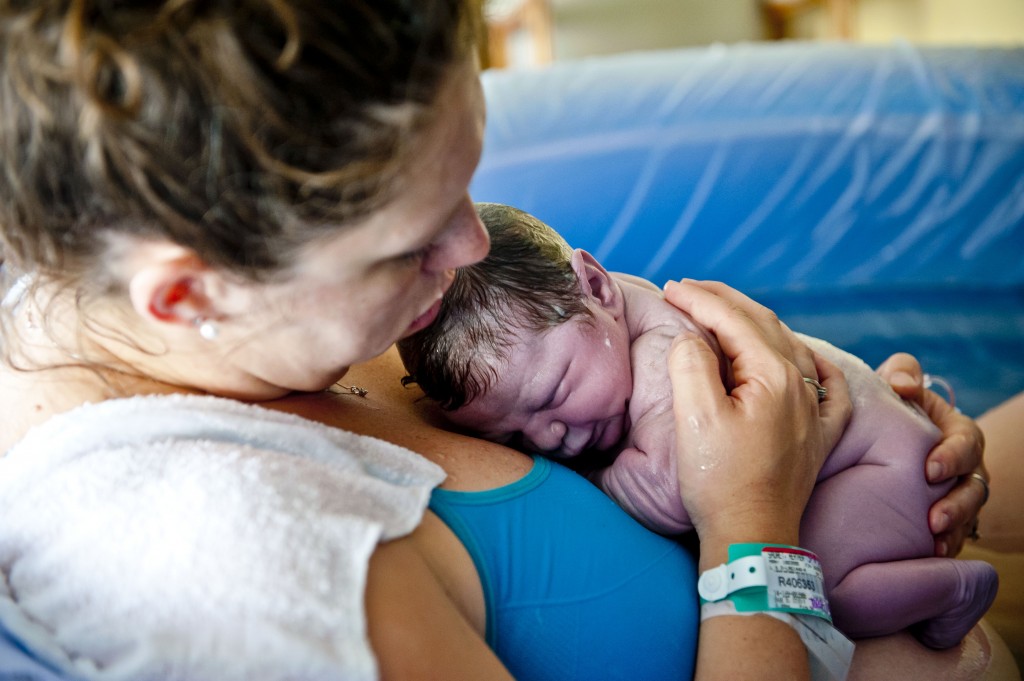“In the end, if we do everything wrong, but he’s born healthy and alive, then none of that matters.”
This is what I used to say all the time leading up to the birth of our first son, Phoenix.
In a way, I still believe it. All of our birth plans for Phoenix went haywire, and yet we’ve been blessed with a child who is smart, gentle and a tremendous joy.
With our second boy, Asher, all of our plans went exactly as we had hoped, and we’re still blessed with a child who is a tremendous joy.
Yet, even though the byproduct was the same — a healthy boy — the two journeys leading up to their births were vastly different.
For Phoenix, we had planned for an all-natural birth. Heather and I had practiced various relaxation techniques and labor positions for months. Leading up to his birth, I would give her calming massages each night. I learned which techniques eased Heather’s anxieties the best, which turned out to be wave-like, gentle presses up and down her body to the rhythm of beach waves coming and leaving the shore. We went to Bradley classes, learned all the signs of early labor, practiced different positions that would allow her body to handle the pain.
“This is designed to hurt,” we kept saying to each other, in part as joke but mostly as a reminder that women have endured natural births for centuries and that God would be with us through it all. And though modern medicine has alleviated much of the pain, it has also produced a factory-like, sterile, laboratory environment in the way it handles the labor process. The modern marvel of birthing oftentimes cheats mothers and fathers of a meaningful and deeply personal experience. There’s nothing intimate or enjoyable about the process hospitals use to deliver babies today, other than the final product in your arms.
When the time came for Phoenix to enter our world, all of our plans and wishes failed. The hospital was our backup plan, and the backup is what we got.
Plan A was to deliver at a beautiful little birthing center just minutes from our home in Pittsburgh. In Pittsburgh, it’s illegal to deliver a baby at home — which I find idiotic — otherwise we might have considered that route.
Heather was about two weeks overdue with no real signs of labor. We had visited the midwives a few times to induce labor naturally. She had been doing just about everything at home: castor oil, going on walks, breast pumping … we even went bowling.
Nothing. No signs.
So we went back to the midwife center for another checkup and to strip her membrane, when Kathy, our midwife on call that day, told us:
“Your water broke.”
Heather and I looked at each other and then at Kathy, a bit puzzled.
You see, just about every the labors scene you watch on TV shows and movies are wrong. In these hyped-up versions of life, you typically see or hear a gushing of liquid, followed by the woman screaming, “My water broke!” and a mad dash to the hospital with full-blown contractions causing the poor mother to scream in pain every 45 seconds. Then pushing comes within the hour.
Real labor isn’t like that.
For Heather, at least, the water breaking was so minimal that she had hardly noticed.
“I thought I just peed myself,” Heather said.
During pregnancy, especially toward the end, women can accidentally pee themselves because their kegel muscle is harder to tighten and control.
So instead of delivering at the birthing center, Kathy suggested we go to Mercy Hospital. Kathy said she would meet us there, which was a tremendous relief because I had feared being put under the pressure and influence of a doctor who might suggest things based on his convenience rather than for Heather’s comfort and actual necessity. Kathy could serve as a buffer at least. She’d be the ambassador to our birth plan wishes.
But once we got there, Kathy recommended Pitocin, a drug that induces contractions and helps labor get started. The downside is that Pitocin prompts much more violent contractions than normal. Heather and I both agreed to the Pitocin because Heather had been having no contractions at all, and once a mother’s water breaks, there are potential dangers to the child if he’s not born within a certain timeframe.
Once Pitocin was injected via a drip, it changed everything.
Heather was hooked to a contraction monitor, laid in a stiff mechanical bed, and tubes ran from the drip bags on a metal stand down to the intravenous hep-locks gadgets inserted and taped down to her arm. The contractions came: harder, faster and more frequently than a woman’s body normally experiences.
And at the same time, I was rendered useless.
Heather couldn’t really move from the bed. I mean, yes, she was allowed, but any step around the room would be followed by a company of plastic tubing, metal stand and electric monitor on wheels.
When I tried our relaxation massage over her body, my hand scraped over the bundle of tubes on her arms. I had no power at all to help my wife relax through the pain. We tried to endure the labor contractions for several hours. The best we could do as far as movement was to switch positions from the bed to a large beach ball to help Heather lean over or sit to displace the hip pain. When we asked the nurses for assistance or suggestions for other relaxing positions, their response was baffled annoyance.
Their faces seemed to say, “What do you mean relaxing positions? It’s labor. You sit in your bed and you take it.”
Of course they didn’t say those words, but I heard them in their silent, polite stammers.
As the contractions intensified, they began about 7 to 10 minutes apart, which is normal, but quickly escalated to 2 – 3 minutes, usually a sign of the latter stage of labor, called transition, meaning that pushing the baby out is not far behind. But when Kathy checked Heather’s cervix for dilation, Heather was only at 3 centimeters. Heather and I had made an agreement that through labor she didn’t want to know her dilation progress. The nurse or midwife would have to pull me aside to tell me privately. That would safeguard Heather from feeling defeated if labor wasn’t progressing as rapidly as we wanted.
But when Kathy told me 3 centimeters and Heather’s contractions had been burning through her body like a torch every 2 minutes — sometimes even back-to-back — and we had been at it for four to five hours, I felt my chest and my courage deflate. When I went back into the room, Heather must have seen it all over my face. No progress was made. Pain would go on, lots of it, and for a long while more.
“You’re doing well,” I said, looking in her eyes, but I’ve always been a terrible liar.
She labored for another hour, thinking that maybe we could persevere and conquer this hill together. But we were fighting a losing battle: A woman’s cervix doesn’t dilate unless her body is relaxed, and how could she relax when the Pitocin made the pain so tremendous, the environment was so controlled and sterile, and I couldn’t even hold or hug my wife because of all the contraptions attached to her body?
Hot tears spilled from Heather’s eyes. She begged me to let the pain stop, and I felt so helpless because there was literally nothing within my body I could give her or do for her to alleviate her pain.
So we went for the epidural.
I don’t meant to sound melodramatic or resentful or unthankful, but submitting to the epidural felt like a defeat.
Heather kept saying, “I’m sorry” to me over and over again after agreeing to the epidural, but I felt like I’d been the one who had failed her, had been unable to help her relax or protect her from the pain. I know that Heather felt like she had failed, and I didn’t want her to believe that burden.
We had planned. We had done everything we could, and now it was time to be thankful that modern technology and medicine was available for her particular situation. It wasn’t the hospital’s fault that Heather’s water had broken. It wasn’t the nurses’ fault that Heather had gone two weeks overdue. Though we disagreed on their general approach and philosophy when it comes to labor, they were not the enemy.
Except, the technician who administered the epidural didn’t help that cause.
When she came into the delivery room, the woman who inserted the needle into Heather’s spine scolded my wife for not keeping still. The contractions had been hitting back to back. Heather’s body convulsed with each wave, and yet she was expected to keep still like a happy little child who was being given a popsicle. In the end, the technician stabbed her spine twice before inserting the needle right. Then she left the room without even offering a smile or a polite farewell.
Relief came quickly.
The drugs dazed Heather and soon she looked like a different woman entirely. One who was floating weightlessly. Pleased and content.
That’s the help her body needed. She relaxed — I mean obviously, how can you not feel relaxed when you’re high on drugs? Her cervix opened much more quickly. I don’t remember how much time passed after that. Once it came time to push, Heather’s mom and I held her legs up in the air because she couldn’t feel anything below her lower part of the spine. Kathy coached her through it, but pushing is already a jerky, almost non-sequitur effort of back-and-forth progress. It didn’t help that Heather was so numbed that she didn’t know whether she was actually pushing or not.
I still remember the squirts of fecal matter that came out and Kathy kept folding hospital pads over and over to tuck them away. Whenever I mention this to Heather she feels self-conscious (obviously) and thinks that I somehow resent that detail. But for me, remembering that detail before finally meeting Phoenix for the first time is essential, somehow. There are a lot of details on that day that have slipped from the chambers of my memory, but holding on to the detail of liquid poop reminds me of how messy and nasty life can be at times, and yet it’s bookended by these beautiful moments of joy. I embrace that grotesque, uncomfortable imagery. It represents Heather in her most vulnerable and yet most powerful state. Vulnerable because she was utterly helpless. Powerful because she gave birth to a life.
When Phoenix’s head crowned, I was in disbelief over what I was seeing. It felt and looked so foreign, the whole thing, even though I had mentally prepared for this for months.
Heather kept pushing, and eventually the full head stretched out like a misshapen purple balloon with hair and Pheonix’s arm was tucked up into his chest, and at first I thought something horrible: Her intestines are coming out! Phoenix’s purple body looked so unlike that of a little human that my brain had a hard time comprehending what it was, until finally Kathy scooped him out completely, and I felt my legs buckle, and I began crying uncontrollably. I felt like I’d been shot in the chest with a sandbag, and it had stunned my entire body.
Kathy placed Phoenix on Heather’s chest, and I grabbed our camera and started shooting. “I want this moment,” I thought. “I want this moment captured so that I can always return to it even if I forget everything else from this day.”
Phoenix’s face was fat and swollen, so much so that he looked like a sumo wrestler, and for a moment I thought he was a black baby because of the way his features and skin tone looked.
“How did a black baby get in there?”
But then I settled back to reality.
I cut the umbilical cord, which was much thicker and tougher than I had imagined, and a nurse plopped Phoenix on the scale. He was one ounce shy of 10 pounds.
He was born around 2:00 a.m. We hoped to get some rest and sleep, but every few hours the nurses came in for one thing or another. Even when I politely asked them to allow us to rest, they continued to come in to check Phoenix for vitals or other medical requirements, put in place more because of liability than necessity. It felt like even when labor was over, a mother was never intended to relax inside a hospital.
—
Two years later, Heather was not very happy with me when I got her pregnant again. We found out while we were in the Bahamas, and we prepared for a second serving of pregnancy and round two of labor.
Our plans for labor were the same, except now we were living 45 minutes outside of Chicago. We found a hospital that offered natural birthing suites and a whole staff of midwives who promote natural childbirth. We were ecstatic to find the place, but at the same time weary that all of our plans might fail again. Especially because, now, we had an added curveball: I was going to be gone on Army duty for two weeks around the time of Asher’s due date.
We prayed and hoped for an early delivery, and felt that hope realized when Heather began experiencing a lot more pre-labor symptoms than she did with Phoenix. We thought labor might come early, but there were several false alarms. Heather tried more of the same natural induction methods as the first time, except this time we threw in an acupuncture treatment, chiropractic adjustments and a deep tissue massage.
We flew in a friend from California who is working toward her doula certification, and Heather’s mother drove in from Pittsburgh to stay with us. We got closer and closer to the due date, but also closer to my departure for the Army. Fortunately my place of duty was about a 5-hour drive north in Fort McCoy, Wisconsin. If Heather went into labor, I might have a chance to drive home in time if I didn’t hit traffic on my way back and the labor didn’t go too quickly.
So I drove off for duty, leaving Heather in the care and company of her friend and mother, and I prayed that God would allow me to be with her when the time came.
About two weeks later, Heather called me at 2:00 a.m. telling me labor had started an hour before.
“Are you sure?” I asked.
She sounded calm and assured.
“Ok, I’m coming,” I said. And it wasn’t a mad dash or a scramble for me. I packed my luggage and Army gear, neatly and calmly. I cleared out my room and loaded my car. I sent a text message to fellow Soldiers to let them know I was leaving, and they wished me luck.
I had barely slept the night prior. We had been working 14-16 hour days covering two different Army competitions, and the trumpet call of Retreat always blared insanely late at night on Fort McCoy, with the loudspeakers placed right outside my window. I had never heard of Retreat playing at 11:00 o’clock at night. Every night. So I had maybe 3 or 4 hours of sleep in me when Heather had called.
I stopped by a gas station before hitting the highway, and I grabbed two jumbo hot dogs and four energy drinks of different brands. One of the hotdogs spilled on my passenger seat, staining the cushion with mustard, and that was the only time I cussed out of frustration during that whole process. I ate both hot dogs and guzzled two of the drinks and made it home in four hours flat, shaving about an hour from the usual drive time.
We labored at home for several hours until the contractions reached an average of 5 minutes apart. There were a few stretches of time when we saw the contraction intervals stretch out and fade, and we worried of yet another false alarm. But eventually their rhythm persisted with consistency.
Once we reached that point, we called the midwife office and made our way to the hospital. The contractions intensified, and by now they made it difficult for Heather to walk. We parked the van and she wobbled slowly across the parking lot holding my arm. A man outside of the front entrance offered us a wheelchair, but Heather declined.
“Thank you, we’re okay,” she said.
I felt calm and steady, and I could tell that Heather felt that same presence within her.
Once inside, I told her to wait while I went to the information desk to see where we needed to go.
“Hi, my wife is in labor, and I was wondering which way we should go.”
I said it just like that. Calmly. Collected. As though I were asking where I might get a good cup of coffee.
The lady at the counter smiled as though I might be joking or pulling her leg. I’m sure that in her experience when husbands approach her desk proclaiming her wife is in labor they usually don’t sound like they’re at Target asking where they might find a garden hose.
“Is she in pain?” she asked, holding a baffled smile at bay.
In response to that, I wanted to say, “Her contractions started 9 hours ago and they’re coming 5 minutes apart and she can hardly walk.”
But instead, I blurted, “M’am, she’s in labor.” Which came out extremely condescending, even though I hadn’t meant it that way.
She looked bothered and insulted, and she might have told me off if it hadn’t been for Heather suddenly wobbling behind me holding her hip and her belly and squeezing her face like she was holding back a baby, which she was.
“I’ll get the wheelchair,” the lady said, and she pushed Heather down a few corridors until we entered the birthing wing.
We entered a small room, which was temporary, and a nurse began hooking Heather up to a monitor and inserted a hep-lock in her arm for an antibiotic they would inject later because of a bacteria Heather had tested positive for.
And I thought, “Oh no. Here we go again with the cables and tubes and the constant monitoring.”
Except, the monitor stayed on only for a while, and the hep-lock, this time, remained free of any IV bags and tubing. Once we moved to the birthing suite, the nurse began filling the birthing tub with warm water. Mara, our midwife, helped Heather adjust from one position to another to give her comfort as the contractions intensified.
Mara was incredible. Calm and sweet and very reassuring through the whole process. Even the nurse was fantastic and gentle. Typically Heather won’t allow anyone to touch her or massage her if she’d never met them before, but when the nurse rubbed Heather’s back at one point, she was motherly and tender and Heather welcomed her touch. Even now, Heather says that she felt very loved by them even though they were almost strangers.
Heather started the labor by resting on the bed, keeping her breathing low and the environment soothing and calm. I massaged her and eased her muscles through the contractions. She hummed and released her body through the pain, falling into a state of relaxation that was a bit surreal to watch for me considering how I had seen her on Pitocin less than three years before.
Contractions came more rapidly, and at four minutes apart, Mara checked Heather’s cervix. She pulled me aside to tell me her progress.
“Five,” she mouthed.
I almost didn’t believe her. Five was great, especially for how calm Heather was. I remember the feel of defeat with Phoenix’s labor when Kathy had told me 3 centimeters and Heather had been writhing in pain for hours. Here and now, the news felt victorious.
We can do this, I thought. Heather can really do this.
Heather moved from the bed, to standing while leaning her body against my chest as we rocked gently back and forth. But soon she felt overheated due to my body’s temperature pressing against her. So she leaned against a tray table that was elevated up to her chest. We placed a pillow there and she leaned into it while I massaged her hips. Then on the ground on her knees leaned over an inflated ball. Then Mara hooked a sort of swing to the ceiling and Heather leaned over it for support. Finally as the pain punched with more intensity, Heather stripped to her bra and we sat her in the shower while we adjusted the water’s temperature to her needs.
The thing was that we never stopped adjusting to give her comfort. In today’s traditional birthing model, comfort comes only in one form: lie on the bed and take this needle into the spine or else suffer the consequences of your stubbornness. But in the natural model, a woman is cared for intimately and personally. She is being served and loved and sympathized. There is no coldness, but warm care.
Mara checked her dilation again, and this time Heather was close to 9 centimeters. Most of the labor was over, but now things would become more painful than ever.
There were moments in the shower when Heather began crying and pleaded with me.
“I can’t do this. It hurts so much. I want it to stop. I can’t do this,” she cried.
But I reassured her every time: “You’re doing it. Right now. You’re doing it.”
She was already so close. If I gave into her begging and whisked her away to an epidural, I knew she would have regretted it later.
I kissed her, looked her in the eyes and told her that I believed in her.
Eventually we moved her to the birthing tub filled with warm water. The water comforted her but it also overheated her, so I ran back and forth refreshing white rags drenched in ice water to cool her off.
At one point, I entered the tub with her and I felt like I was really part of this life about to land in our arms. I held her and soothed her in the water and, unlike our last labor, I felt like my body could provide her with comfort and strength. We were one. We were together in this.
Eventually, she switched positions within the tub to prepare for pushing.
I have never seen an exorcism in real life, but I will tell you that after watching my wife go through labor and pushing without any drugs, I think I could face a real exorcism if I had to.
Things intensified.
Heather’s low moans became grunts, almost beastly in sound and nature. Her eyes filled with what looked like a tamed rage. When I tried to coach her through the pain with encouragement she shouted at me to shut up.
“I love you, but I really need you to shut up, right now, okay? Just shut up!”
I couldn’t help but laugh. I didn’t meant to. I wasn’t trying to mock her or laugh at her, but it was such an absurd and strange transformation of Heather’s tame and kind character that I couldn’t help but laugh in disbelief. Several times, I had to walk away from the tub holding my mouth so I wouldn’t burst out at the seams of my lips with laughter.
So I tried not to speak, asking questions only to see what she needed. At times I offered her the straw to a cup of ice water and she shook her head violently no, as if to say, “Get that thing away from my face,” and then minutes later I’d offer that same straw and she latched on vigorously to fill her thirst.
The whole time, Mara and the nurse took turns scooping turds out of the water using a little fish net and hospital rags.
Oh, here we are, just catching some turds out of the water. Just another day in the life of birthing life.
I was there in the moment between two extremes: the way these two women treated turd catching with such an ordinary demeanor, and how intense and out-of-this-world Heather’s grunts and anger were toward me that I felt so childish in my bones.
She grunted and screamed and I laughed half silly and sleep deprived, imagining scenes from different exorcism movies in my head and how they looked so much like what I was seeing in real life right now.
Then, in the midst of screams that sounded more like war cries, I actually thought her hair might turn blond and she might go Super Saiyan on me.
“What is happening to me?” Heather screamed several times. “What is going on? Why does it hurt so much?”
There was also clarity between contractions and pushes where Heather talked to us and asked for guidance. Mara coached her through it, but mostly assured Heather that she needed to give in to whatever cues her body gave her. To push only when it felt right in her body.
“Push? I thought I’d been pushing. Haven’t I been pushing? Am I doing it wrong?”
And that’s a moment where I didn’t feel like laughing at all because I could see how fragile Heather’s state of mind was in all of this pain, of how easily defeated she might become if she thought she’d been doing this wrong.
Of course, that was a silly notion. There was nothing wrong with what Heather was doing. It was among the most natural and ordinary actions of life, and yet extraordinary at the same time.
She rested between pushes and contracted her body down and low when the urge came. Yet she was filled with so much doubt because even though this was her second birth, she had been completely numbed and cut off from her body’s experience during the first. There was nothing she could hold onto as a physical reminder or guide to whether or not she was pushing correctly. She had to go entirely by present feeling and unrelenting pain. Whatever relief she received was brief. Whatever push she thrusted felt unsure and full of doubt. Every step forward was followed by one or two backward.
But she endured. She persevered. She conquered.
Once Heather finally pushed Asher out, I wasn’t in the right position to see him. Heather later said she watched Asher kick his little hands and feet like a little swimmer up until he reached the water’s surface. I wish I could have seen that.
When Heather saw him swim, she asked Mara what she should do.
“Go ahed and pick up your baby boy,” Mara said.
Heather caught Asher and placed him on her chest, where he took his first lung breaths of life.
“Hi baby,” Heather said, and cried.
Again, just like it happened with Phoenix, my body crumpled to the weight of joy. I laughed between bursts of tears and crying. Heather had done it. Asher was alive. We had two boys.
I ran for the camera and captured the very first moments of our son’s new life. It was incredible. Then I threw my camera on the bed — I threw it hard like it was insignificant, even though it cost nearly $5,000 with lens and all when I first bought it — and I ran back to my wife and new baby to cherish the moment.
This moment.
I told Heather I loved her and I was so proud of her. Then I held Asher on my bare chest on a chair, him still covered in his birthing fluids, while Mara and the nurse stitched Heather up behind me on the bed. Even after all that — the hours of labor, transition, pushing — there was little relief or escape from pain for Heather as the two women needled a tear she had suffered.
I’m incredibly proud of what Heather was able to endure. I’m incredibly proud of our two sons, and thankful to God almighty for these two beautiful lives He’s entrusted in our care.
Heather, I think, feels redeemed in a way by having been able to give birth naturally. Obviously that’s an unnecessary feeling. There was nothing that needed redeemed from the way Phoenix was born. Yes, the experience was unpleasant, but there are much worse things in this world to suffer than unpleasantness.
Phoenix is alive. Asher is alive. They were born exactly two and a half years apart. On the calendar, their births are celebrated six months apart to the day. That means that they are as far apart on the calendar as chronologically possible. In a way, that separation in birth dates might symbolize the fact that their birth stories are also held on the opposite spectrums of medical philosophies. One boy was born in the late fall, and the other in the height of spring.
Fortunately, the story of a person’s birth is nothing but a momentary speck compared to the journey of the rest of their lives. The average person lives a little more than 27,000 days, and this is just one of them. It’s nothing but a fingernail clipping when compared to the rest of the body. And yet, I greatly believe that women ought to be treated in the most caring, compassionate and sympathetic manner possible on the day they’re going to be their most vulnerable.
Decisions and hospital environments should be made based on her needs and her comforts, not based on personal convenience for the staff or monetary gain. Fortunately, I believe that most of the unpleasant circumstances we suffered for Phoenix’s birth were necessary. But too often women are squeezed into this one-size-fits-all birthing mold, or worse, convinced that a cesarean section is necessary when it actually might not be. I’m okay with any woman getting an epidural if she wants one. A woman doesn’t have to be in pain if she doesn’t want to be, just as long as each woman is treated based on her individual cares and wants and not based on the laws of average and financial gain. A C-section is a heck of a lot more profitable than a vaginal birth (usually a $20,000 difference).
I often think back to the day when my own sister was in labor with her second baby, and I was being harsh with her while she was on the hospital bed. Now that Heather’s gone through this process twice, I realize what an incredible jerk I was to my sister in that moment. I should have been massaging her feet or caressing her hair! Not scolding her over some petty disagreement!
This is when our women need our most passionate strength and patient love as men. I applaud and encourage any man who is alongside his wife — or even girlfriend — during the time of birth. What you do here, and how you prepare for this day, often sets the tone for how you plan on prioritizing your life ever-rafter and how you treat your wife during her most needed times.
What about you?
What was your experience during the birth of your children?
 Michel Sauret – Award-Winning Army Journalist | Independent Author Award-Winning Army Journalist, Independent Author
Michel Sauret – Award-Winning Army Journalist | Independent Author Award-Winning Army Journalist, Independent Author















2 comments
Pingback: One Way Street Production // Chicago Family & Wedding Photography // Veteran Owned Small Business » Newborns are an adjustment! Taking our baby to the chiropractor was quasi-miraculous.
Pingback: The longest labor | Michel Sauret – Award-Winning Army Journalist | Independent Author